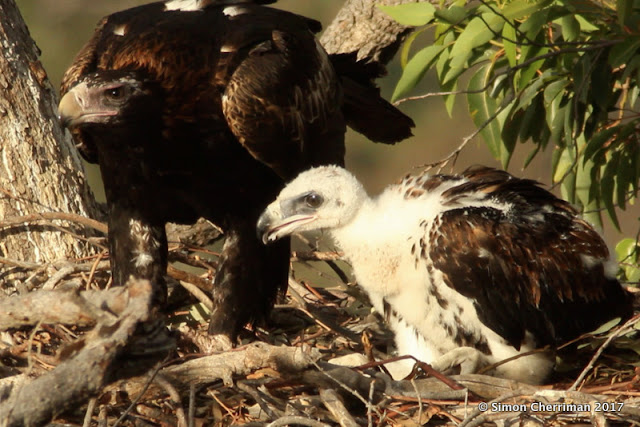If you've been following my Instagram feed, you've probably seen the range of photos captured from the tree hide I constructed last month to observe a late-hatching Wailitj / Wedge-tailed Eagle chick in the Perth Hills, whose nest is pictured above. My first glimpse of this eaglet, which I would later find out was a female, was in November when she was a month old and her flight feathers had only just emerged.
When I did my first hide stint a few weeks later, the eaglet had made a rapid transformation from almost entirely white to about half chocolate-brown. Eaglets are normally very vocal at the sight of their parents, and virtually mute at other times, but even when her parents were absent (which, at the age of six weeks, was often), this girl called almost incessantly, her loud, two-noted yelps filling my eardrums. It was wonderful to observe her mother feeding her small pieces of Yoorn / Bobtail Skink (Tiliqua rugosa) that the male delivered early one morning, and I was very happy to obtain some video footage that will be useful for my next documentary.
Today's mission, however, was to ascend to this nest, remove the eaglet (who was now 10 weeks old) for a brief period to weigh, measure, colour-ring and satellite-tag her, then place her back as she was found. I was slightly nervous as I scaled a climbing rope high into the canopy to reach the eyrie, which was about 25 m above the forest floor. The juvenile eagle greeted me in the way that most do: with a 'threat display' that includes spread out wings and a gaping, sometimes drooling mouth, an expression that says: "I'm going to kill you, so stay back!"
 |
| "Welcome to my eyrie... now I keeeeel you!" |
I was lucky to be joined on this 'eagle day' by a variety of helpers and onlookers, one of whom was my old friend and expert photographer Judy Dunlop, who managed to captured some great memories of how the afternoon unfolded, including this eye-level canopy shot of the 'capture moment'...
Back on terra firma, my partner Danielle did a wonderful job of calmly holding the eagle as I took measurements. It was a thrill to have Trish Fleming, one of my PhD supervisors, with me to help fit her with colour-rings. So much effort goes into planning and supervising doctoral research, so sharing moments in the field with those people who give monumental 'behind the scenes' support is especially rewarding.
 |
| Trish holds the colour-ring closed as I prepare to fix it with a pop-rivet. |
Another person whose presence was a special blessing was Noongar woman Alison Murphy, who came along to meet the eagle and give her a Noongar name. Alison's father Noel Nannup named one of our 2016 birds 'Yirrabiddi', who is still flying around inland Western Australia, so it was great to introduce another member of the Nannup family to another member of the Wailitj one!
 |
| Alison Murphy attaches the final rivet to the eagle's colour-ring while Dani holds her. |
Once we had finished taking measurements and fitting the colour-rings, it was time to accomplish the main aim of the mission and attach the satellite transmitter. If you've read other posts on this intricate procedure, you'll know it is done using a cardboard template which holds the Telfon harness straps in place while they are stitched. Dani continued her expert handling and seemed to give off soft, calming vibes that cast a spell on our subject, which made the tagging process straightforward and stress-free.
After observing the eagle's calm and placid behaviour during the ringing and tagging process, Alison decided the Noongar word 'kwidi', which means patiently waiting, would make a fitting name. Having spent so much time patiently waiting in my tree hide to observe her behaviour over the past few weeks, I agreed wholeheartedly! With the stitching on her transmitter harness complete, Kwidi was gently placed back in the handling bag and hoisted home.
Kwidi would be the 22nd and final juvenile eagle I had fitted with a transmitter for this current research project. What an amazing feeling to have completed a huge part of my PhD fieldwork! I plan to return soon after Christmas to make more hide observations, and spend more time in the canopy, patiently waiting.
 |
| It is always wonderful to be accompanied in the field by a bunch of great people. |














































